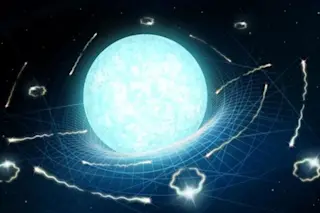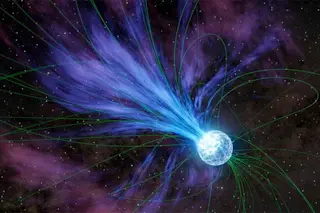In the aftermath of the dispiriting comments following last week’s post on the Parapsychological Association, it seems worth spelling out in detail the claim that parapsychological phenomena are inconsistent with the known laws of physics. The main point here is that, while there are certainly many things that modern science does not understand, there are also many things that it does understand, and those things simply do not allow for telekinesis, telepathy, etc. Which is not to say that we can prove those things aren’t real. We can’t, but that is a completely worthless statement, as science never proves anything; that’s simply not how science works. Rather, it accumulates empirical evidence for or against various hypotheses. If we can show that psychic phenomena are incompatible with the laws of physics we currently understand, then our task is to balance the relative plausibility of “some folks have fallen prey to sloppy research, unreliable testimony, confirmation bias, and wishful thinking” against “the laws of physics that have been tested by an enormous number of rigorous and high-precision experiments over the course of many years are plain wrong in some tangible macroscopic way, and nobody ever noticed.”
The crucial concept here is that, in the modern framework of fundamental physics, not only do we know certain things, but we have a very precise understanding of the limits of our reliable knowledge. We understand, in other words, that while surprises will undoubtedly arise (as scientists, that’s what we all hope for), there are certain classes of experiments that are guaranteed not to give exciting results — essentially because the same or equivalent experiments have already been performed.
A simple example is provided by Newton’s law of gravity, the famous inverse-square law. It’s a pretty successful law of physics, good enough to get astronauts to the Moon and back. But it’s certainly not absolutely true; in fact, we already know that it breaks down, due to corrections from general relativity. Nevertheless, there is a regime in which Newtonian gravity is an effective approximation, good at least to a well-defined accuracy. We can say with confidence that if you are interested in the force due to gravity between two objects separated by a certain distance, with certain masses, Newton’s theory gives the right answer to a certain precision. At large distances and high precisions, the domain of validity is formalized by the Parameterized Post-Newtonian formalism. There is a denumerable set of ways in which the motion of test particles can deviate from Newtonian gravity (as well as from general relativity), and we can tell you what the limits are on each of them. At small distances, the inverse-square behavior of the gravitational force law can certainly break down; but we can tell you exactly the scale above which it will not break down (about a tenth of a millimeter). We can also quantify how well this knowledge extends to different kinds of materials; we know very well that Newton’s law works for ordinary matter, but the precision for dark matter is understandably not nearly as good.
This knowledge has consequences. If we discover a new asteroid headed toward Earth, we can reliably use Newtonian gravity to predict its future orbit. From a rigorous point of view, someone could say “But how do you know that Newtonian gravity works in this particular case? It hasn’t been tested for that specific asteroid!” And that is true, because science never proves anything. But it’s not worth worrying about, and anyone making that suggestion would not be taken seriously.
As with asteroids, so with human beings. We are creatures of the universe, subject to the same laws of physics as everything else. As everyone knows, there are many things we don’t understand about biology and neuroscience, not to mention the ultimate laws of physics. But there are many things that we do understand, and only the most basic features of quantum field theory suffice to definitively rule out the idea that we can influence objects from a distance through the workings of pure thought.
The simplest example is telekinesis, the ability to remotely move an object using only psychic powers. For definitiveness, let’s consider the power of spoon-bending, claimed not only by Uri Geller but by author and climate skeptic Michael Crichton.
What do the laws of physics have to say about spoon-bending? Below the fold, we go through the logic.
Spoons are made of ordinary matter.
This sounds uncontroversial, but is worth explaining. Spoons are made of atoms, and we know what atoms are made of — electrons bound by photons to an atomic nucleus, which in turn consists of protons and neutrons, which in turn are made of quarks held together by gluons. Five species of particles total: up and down quarks, gluons, photons, electrons. That’s it.
There is no room for extra kinds of mysterious particles clinging, aura-like, to the matter in a spoon. That’s because we know how particles behave. If there were some other kind of particle in the spoon, it would have to interact with the ordinary matter we know is there — otherwise it wouldn’t stick, it would just zip right through, as neutrinos zip right through the Earth nearly undisturbed. And if there were a kind of particle that interacted with the ordinary particles in the spoon strongly enough to stick to the spoon, we could easily make it in experiments. The rules of quantum field theory directly relate the interaction rates of particles to the ease with which we can create them in the lab, given enough energy. And we know exactly how much energy is available in a spoon; we know the masses of the atoms, and the kinetic energy of thermal motions within the metal. Taken together, we can say without any fear of making a mistake that any new particles that might exist within a spoon would have been detected in experiments long ago.
Again: imagine you have invented a new kind of particle relevant to the dynamics of spoons. Tell me its mass, and its interactions with ordinary matter. If it’s too heavy or interacts too weakly, it can’t be created or captured. If it is sufficiently light and strongly interacting, it will have been created and captured many times over in experiments we have already done. There is no middle ground. We completely understand the regime of spoons, notwithstanding what you heard in The Matrix.
Matter interacts through forces.
We’ve known for a long time that the way to move matter is to exert a force on it — Newton’s Law, F=ma, is at least the second most famous equation in physics. In the context of quantum field theory, we know precisely how forces arise: through the exchange of quantum fields. We know that only two kinds of fields exist: bosons and fermions. We know that macroscopic forces only arise from the exchange of bosons, not of fermions; the exclusion principle prohibits fermions from piling up in the same state to create a coherent long-range force field. And, perhaps most importantly, we know what forces can couple to: the properties of the matter fields that constitute an object. These properties include location, mass, spin, and various “charges” such as electric charge or baryon number.
This is where the previous point comes in. Spoons are just a certain arrangement of five kinds of elementary particles — up and down quarks, gluons, electrons, and photons. So if there is going to be a force that moves around a spoon, it’s going to have to couple to those particles. Once you tell me how many electrons etc. there are in the spoon, and the arrangement of their positions and spins, we can say with confidence how any particular kind of force will influence the spoon; no further information is required.
There are only two long-range forces strong enough to influence macroscopic objects — electromagnetism and gravity.
Of course, we have worked hard to discover different forces in nature, and so far we have identified four: gravitation, electromagnetism, and the strong and weak nuclear forces. But the nuclear forces are very short-range, smaller than the diameter of an atom. Gravitation and electromagnetism are the only detectable forces that propagate over longer distances.
Could either gravitation or electromagnetism be responsible for bending spoons? No. In the case of electromagnetism, it would be laughably easy to detect the kind of fields necessary to exert enough force to influence a spoon. Not to mention that the human brain is not constructed to generate or focus such fields. But the real point is that, if it were electromagnetic fields doing the spoon-bending, it would be very very noticeable. (And the focus would be on influencing magnets and circuits, not on bending spoons.)
In the case of gravitation, the fields are just too weak. Gravity accumulates in proportion to the mass of the source, so the arrangement of particles inside your brain will have a much smaller gravitational effect than just the location of your head — and that’s far too feeble to move spoons around. A bowling ball would be more efficient, and most people would agree that moving a bowling ball past a spoon has a negligible effect.
Could there be a new force, as yet undetected by modern science? Of course! I’ve proposed them myself. Physicists are by no means closed-minded about such possibilities; they are very excited by them. But they also take seriously the experimental limits. And those limits show unambiguously that any such new force must either be very short-range (less than a millimeter), or much weaker than gravity, which is an awfully weak force.
The point is that such forces are characterized by three things: their range, their strength, and their source (what they couple to). As discussed above, we know what the possible sources are that are relevant to spoons: quarks, gluons, photons, electrons. So all we have to do is a set of experiments that look for forces between different combinations of those particles. And these experiments have been done! The answer is: any new forces that might be lurking out there are either (far) too short-range to effect everyday objects, or (far) too weak to have readily observable effects.
Here is a plot of the current limits on such forces, from the Eot-Wash group at Julianne’s home institution. This particular plot is for forces that couple to the total number of protons plus neutrons; similar plots exist for other possible sources. The horizontal axis is the range of the force; it ranges from about a millimeter to ten billion kilometers. The vertical axis is the strength of the force, and the region above the colored lines has been excluded by one or more experiments. On meter-sized scales, relevant to bending a spoon with your mind, the strongest possible allowed new force would be about one billionth the strength of gravity. And remember, gravity is far too weak to bend a spoon.
That’s it. We are done. The deep lesson is that, although science doesn’t know everything, it’s not “anything goes,” either. There are well-defined regimes of physical phenomena where we do know how things work, full stop. The place to look for new and surprising phenomena is outside those regimes. You don’t need to set up elaborate double-blind protocols to pass judgment on the abilities of purported psychics. Our knowledge of the laws of physics rules them out. Speculations to the contrary are not the provenance of bold visionaries, they are the dreams of crackpots.
A similar line of reasoning would apply to telepathy or other parapsychological phenomena. It’s a little bit less cut and dried, because in the case of telepathy the influence is supposedly traveling between two human brains, rather than between a brain and a spoon. The argument is exactly the same, but there are those who like to pretend that we don’t understand how the laws of physics work inside a human brain. It’s certainly true that there is much we don’t know about thought and consciousness and neuroscience, but the fact remains that we understand the laws of physics in the brain regime perfectly well. To believe otherwise, you would have to imagine that individual electrons obey different laws of physics because they are located in a human brain, rather than in a block of granite. But if you don’t care about violating the laws of physics in regimes where they have been extensively tested, then anything does in fact go.
Some will argue that parapsychology can be just as legitimately “scientific” as paleontology or cosmology, so long as it follows the methodology of scientific inquiry. But that’s a slightly too know-nothing attitude to quite hold up. If parapsychologists followed the methodology of scientific inquiry, they would look what we know about the laws of physics, realize that their purported subject of study had already been ruled out, and within thirty seconds would declare themselves finished. Anything else is pseudoscience, just as surely as contemporary investigation into astrology, phrenology, or Ptolemaic cosmology. Science is defined by its methods, but it also gets results; and to ignore those results is to violate those methods.
Admittedly, however, it is true that anything is possible, since science never proves anything. It’s certainly possible that the next asteroid that comes along will obey an inverse-cube law of gravity rather than an inverse-square one; we never know for sure, we can only speak in probabilities and likelihoods. Given the above, I would put the probability that some sort of parapsychological phenomenon will turn out to be real at something (substantially) less than a billion to one. We can compare this to the well-established success of particle physics and quantum field theory. The total budget for high-energy physics worldwide is probably a few billion dollars per year. So I would be very happy to support research into parapsychology at the level of a few dollars per year. Heck, I’d even be willing to go as high as twenty dollars per year, just to be safe.
Never let it be said that I am anything other than open-minded.













